Hearts In The Ice 2020-2021
Citizen Science![]() Citizen science exemplifies the power of community to effect change and power the cutting edge of science. Citizen scientists are ‘ordinary’ people who apply their own knowledge and expertise to work in tandem with professional scientists, bringing diverse perspectives and ground-truth data to some of the world’s most difficult problems.
Citizen science exemplifies the power of community to effect change and power the cutting edge of science. Citizen scientists are ‘ordinary’ people who apply their own knowledge and expertise to work in tandem with professional scientists, bringing diverse perspectives and ground-truth data to some of the world’s most difficult problems.
Citizen Science at Bamsebu 2020-2021
Good News?
![]() Awareness and discussion about climate and the environment is much more serious than it was 40 years ago. Most people also have some knowledge and thoughts about what they can do and maybe want / can do.
Awareness and discussion about climate and the environment is much more serious than it was 40 years ago. Most people also have some knowledge and thoughts about what they can do and maybe want / can do.
Coronavirus is not good news. But society’s response shows that we can make rapid changes. It is important to make people understand that climate and environment are as important as their own lives now. But it’s also about the lives of children and grandchildren.
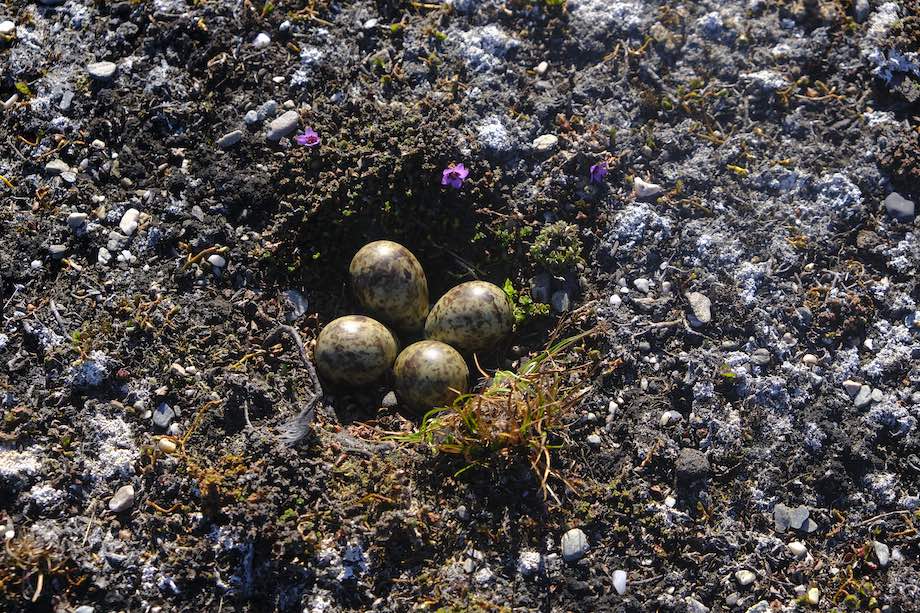
![]()
“Hearts in the Ice is more than a project, more than two brave women managing to stay on their own during a polar winter. It is a model of how scientists, industrial partners, explorers, artists and other stakeholders can meet in a common action to focus on polar climate changes. They are following in the footsteps of other polar pioneers, but this time not hunting for fur and skins, but knowledge and wisdom” – Borge Damsgard, Director – UNIS
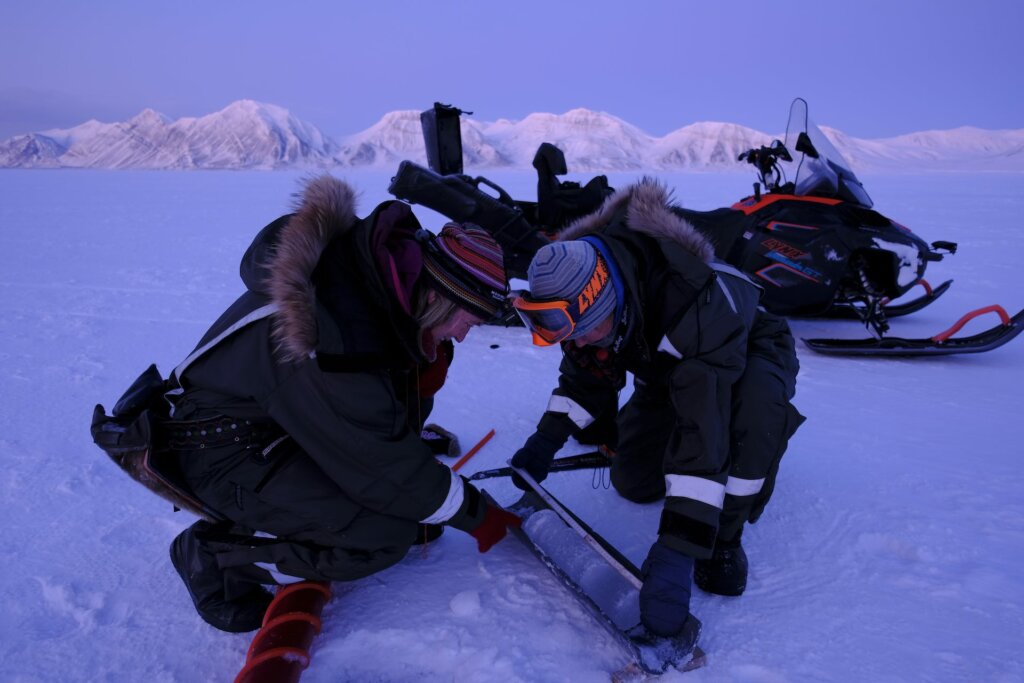
![]() Hearts In The Ice is an excellent example of the power of ordinary, dedicated people in extraordinary places to contribute to citizen science.
Hearts In The Ice is an excellent example of the power of ordinary, dedicated people in extraordinary places to contribute to citizen science.
Hilde and Sunniva serve as citizen scientists by collecting data for existing research being conducted in the Arctic. Due to their combined 46 years of observations and experience in the Arctic and Antarctic, they are uniquely qualified and inspired to be of service in this way.
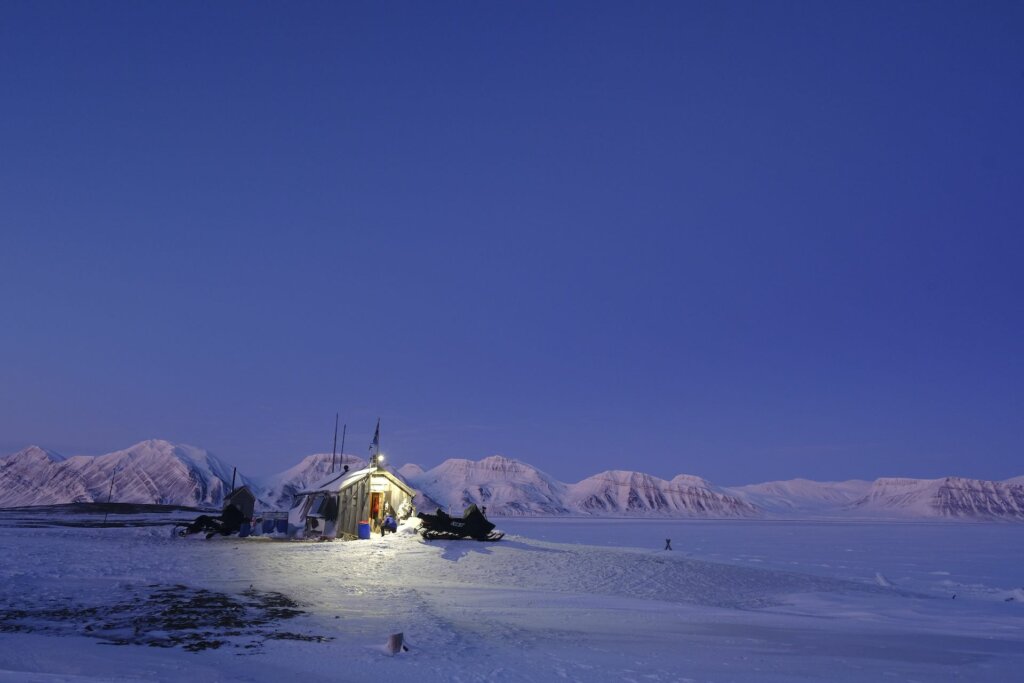
![]() The remote, historic trapper’s cabin “Bamsebu” in the High Arctic -78°N. in Svalbard, Norway, offers a unique vantage point of the Earth. It is located in the VanKeulen fjord – one of the only two fjords (with van Mijen’s) in the West coast of Spitsbergen that still experiences sea ice formation. This area has been investigated for effects of ongoing climate change by a number of projects that usually have been of short duration and mainly in summer seasons.
The remote, historic trapper’s cabin “Bamsebu” in the High Arctic -78°N. in Svalbard, Norway, offers a unique vantage point of the Earth. It is located in the VanKeulen fjord – one of the only two fjords (with van Mijen’s) in the West coast of Spitsbergen that still experiences sea ice formation. This area has been investigated for effects of ongoing climate change by a number of projects that usually have been of short duration and mainly in summer seasons.
Bamsebu allows for year-round observations that can strengthen and enhance scientists’ ability to utilize remote sensing data to evaluate that climatic state in the region.
Citizen Science at Bamsebu
What Happened in 2019-2020?
![]() The first 12 months in Bamsebu have been fulfilled with discoveries and challenges, with a variety of collected data:
The first 12 months in Bamsebu have been fulfilled with discoveries and challenges, with a variety of collected data:
![]() 50-plus close polar bear encounters/ 2 Poop samples
50-plus close polar bear encounters/ 2 Poop samples
![]() 22-plus pre-programmed Indro-Robotics infrared drone flights – coldest temp flown in-27’c
22-plus pre-programmed Indro-Robotics infrared drone flights – coldest temp flown in-27’c
![]() 6 insect samples over 2 months
6 insect samples over 2 months
![]() 16 ice core samples- longest one was 81cm/ 16 saltwater samples/10 phytoplankton samples
16 ice core samples- longest one was 81cm/ 16 saltwater samples/10 phytoplankton samples
![]() 21-plus NASA cloud observations
21-plus NASA cloud observations
![]() 60 NASA aurora time-lapse series- coldest temp -34’c
60 NASA aurora time-lapse series- coldest temp -34’c
![]() 1 NASA rocket launch photo capture
1 NASA rocket launch photo capture
![]() Wildlife observed:
Wildlife observed:
Polar Bears, Arctic Foxes, Belugas, Minke Whales, Walruses, Bearded Seals, Ptarmigans, Reindeer, Pink-footed Geese, Barnacle/Brent geese, Common Eiders, King Eiders, Northern Fulmars, Sanderlings, Purple Sandpipers, Skuas – Long tailed/Arctic, Kittiwakes, Glaucous Gulls, Iceland Gulls, Arctic Terns, Brunnich’s /black Guillemots, Little Auks, Snow Buntings, Puffins & Whooper Swans!
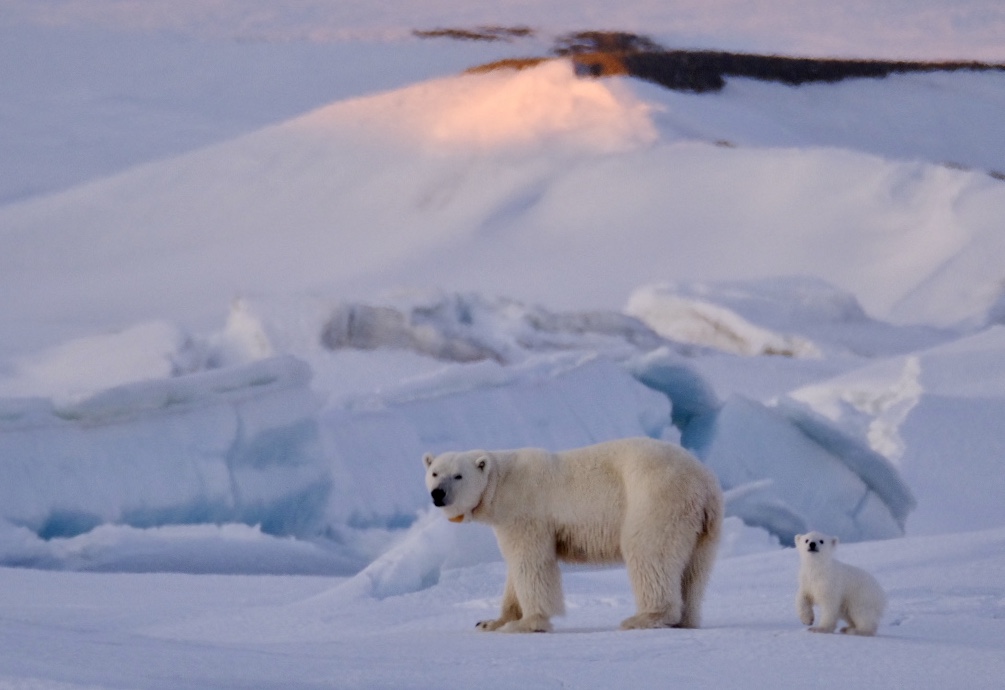
![]() All this precious data has been conveyed to our world-renowned science partners for analysis. By collecting samples over such an extended period, Sunniva and Hilde contribute to a greater dataset that helps scientists deconvolve the connections between climate and ecosystems in the region and interpret large-scale changes that simply speaking will decide not only the fate of polar nature, but presumably the existence of the world as we know it.
All this precious data has been conveyed to our world-renowned science partners for analysis. By collecting samples over such an extended period, Sunniva and Hilde contribute to a greater dataset that helps scientists deconvolve the connections between climate and ecosystems in the region and interpret large-scale changes that simply speaking will decide not only the fate of polar nature, but presumably the existence of the world as we know it.
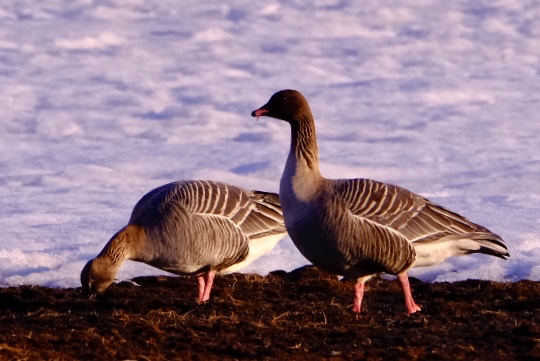
![]() In 2019-2020, Sunniva and Hilde carried several citizen-science projects with the following partners and all of these will continue from November 2020 through May 2021 .
In 2019-2020, Sunniva and Hilde carried several citizen-science projects with the following partners and all of these will continue from November 2020 through May 2021 .
Hearts In The Ice
Citizen Science Projects for 2020-2021
![]()
Citizen Science at Bamsebu 2020-2021
Auroras / Aurorasaurus
![]() At 140 km from Longyearbyen, Hilde and Sunniva will literally be closer to space, and the bottom edge of the beautiful aurora (100 km) than they are to people. With 100 days in total darkness they have a unique opportunity to contribute to aurora observations. The HITI expedition will participate as volunteers and inspire people around the world to participate in documenting changes of all kinds.
At 140 km from Longyearbyen, Hilde and Sunniva will literally be closer to space, and the bottom edge of the beautiful aurora (100 km) than they are to people. With 100 days in total darkness they have a unique opportunity to contribute to aurora observations. The HITI expedition will participate as volunteers and inspire people around the world to participate in documenting changes of all kinds.
Auroras are born of the interaction between nitrogen and oxygen in Earth’s atmosphere and incoming charged particles previously trapped in the magnetosphere. Geomagnetic storms, which can energize the magnetosphere with large amounts of charged particles, directly impact the creation and appearance of auroras. Scientists aren’t yet able to reliably and accurately predict space weather disturbances like geomagnetic storms, but large geomagnetic disturbances can affect the functionality of communications systems and power grids, so predicting their arrival is important.
Aurorasaurus collects ground-truth data on auroras to improve space weather nowcasting and contribute to refining models. Because citizen scientist reports of auroras provide more localized, real-time information about where auroras are, they are also helpful in learning more about the conditions around aurora sightings themselves. As the presence of auroras indicates an influx of charged particles into our atmosphere, observing and documenting their appearances can help us understand more about more impactful space weather events.
Sunniva and Hilde have been contributing to the Aurorasaurus citizen science project, gathering ground-truth data about auroras from one of the best aurora-viewing locations in the world. The Bamsebu trapper’s cabin also has a clear view of scientific rocket flights from two Norwegian launch sites. Aurorasaurus connected Hearts in the Ice with international rocket scientists who use artificial aurora to study the upper atmosphere from Norway. In coordination with a sounding rocket launch, Hearts in the Ice contributed photographic data that can complement other data being gathered and provide a unique perspective that helps to better unravel the complex four-dimensional dynamics at play.
![]()
“Hearts in the Ice is an excellent example of the power of ordinary, dedicated people in extraordinary places to contribute to aurora science in a new way. Each day, Hilde and Sunniva demonstrate the power, tenacity, and skill that citizen scientists contribute to scientific advances.” – Liz MacDonald, Aurorasaurus.
Citizen Science at Bamsebu 2020-2021
Drone Flights / BCIT
![]() Remotely Piloted Aircraft Systems (RPAS), commonly known as drones, are amazing technological tools for environmental data gathering. The visible and thermal data collected by drones has numerous applications from quantification of surface phytoplankton concentration, to wildlife observation, and snow-depth estimation.
Remotely Piloted Aircraft Systems (RPAS), commonly known as drones, are amazing technological tools for environmental data gathering. The visible and thermal data collected by drones has numerous applications from quantification of surface phytoplankton concentration, to wildlife observation, and snow-depth estimation.
Sunniva and Hilde have carried out 22 Indro-Robotics drone flights over the period of twelve months, and the resulting 3D maps are the only data of its kind captured over the course of the autumn, winter, spring and summer seasons at one constant location. Furthermore, it adds tremendous value to determine whether drones can effectively be deployed into harsh Polar areas to gather data related to climate change.
![]()
“Through HITI, Sunniva and Hilde are ground-breaking pioneers in leading citizen science-based climate change research. They are selfless, fearless and through sheer determination, they are a true inspiration for all of us to take action and reduce the negative human impact on climate change” – Eric Saczuk, BCIT
Citizen Science at Bamsebu 2020-2021
Phytoplankton, saltwater- sea temperature / Scripps Institution of Oceanography- FjordPhyto
![]() Phytoplankton are microscopic algae that drift in the oceans. They play a critical role in drawing carbon dioxide out of the atmosphere and contribute to over half of the Earths’s oxygen- more than the trees and plants on land combined.
Phytoplankton are microscopic algae that drift in the oceans. They play a critical role in drawing carbon dioxide out of the atmosphere and contribute to over half of the Earths’s oxygen- more than the trees and plants on land combined.
Phytoplankton stands at the base of the marine food web and its distribution and abundance is changing throughout the season but also with the changing climate. Water clarity and hence phytoplankton abundance can be measured using a Secchi disk. The Secchi depth is the depth below the surface at which to measure water clarity – which is when a Secchi disk disappears from sight when it is lowered vertically into seawater from a boat or other.
Phytoplankton are the key to life. Its important to learn more about these organisms and one way to do that is by sampling frequently throughout the season to get an understanding of which types of phytoplankton are there and how they change from month to month.
Sunniva and Hilde have been able to collect phytoplankton throughout the Arctic winter – something few scientists have funding or resources and time to accomplish. By collecting samples over time this contributes to a greater dataset that helps scientists understand how melting glaciers influences phytoplankton.
![]()
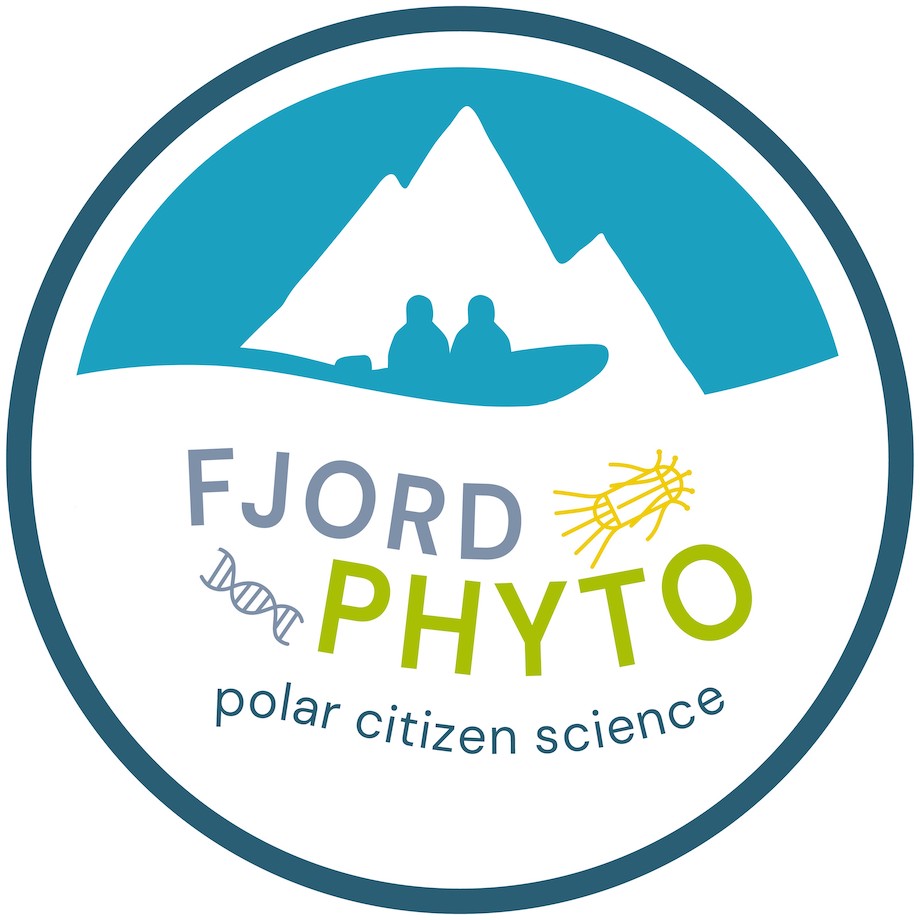 “We are so thrilled Sunniva and Hilde are bringing awareness to the poles
“We are so thrilled Sunniva and Hilde are bringing awareness to the poles
and have partnered as Citizen Scientists  with FjordPhyto! The polar regions are dynamic and changing fast. These changes affect the biology of the ecosystem, starting with the food source – phytoplankton.” – Allison Cusick, FjordPhyto Project Lead Scripps Institution of Oceanography
with FjordPhyto! The polar regions are dynamic and changing fast. These changes affect the biology of the ecosystem, starting with the food source – phytoplankton.” – Allison Cusick, FjordPhyto Project Lead Scripps Institution of Oceanography
Citizen Science at Bamsebu 2020-2021
Snow Samples, Plastic Collection, Dissection of Fulmar stomach lining for plastics / Norsk Polar Institutt
![]() HITI will collect plastic during their entire stay. Litter is causing extensive pollution of the seas, contaminating the shores, the seabed and the water itself. Animals may suffer considerable injury and suffering. Pollutants and alien species can also be spread with the litter.
HITI will collect plastic during their entire stay. Litter is causing extensive pollution of the seas, contaminating the shores, the seabed and the water itself. Animals may suffer considerable injury and suffering. Pollutants and alien species can also be spread with the litter.
In addition to collecting plastic they will also dissect the stomach for microplastics of any dead Fulmars that are found and will mark with Species, date and location. The Northern fulmar is primarily a pelagic species which remains far out at sea except during the breeding season. They feed on small pelagic animals near the sea surface; in Svalbard they feed mainly on squid, 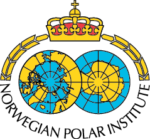 polychaetes, pteropods, crustaceans and small fish. They often mistake microplastics as a food source, which eventually renders their stomach incapable of digestion which leads to starvation.
polychaetes, pteropods, crustaceans and small fish. They often mistake microplastics as a food source, which eventually renders their stomach incapable of digestion which leads to starvation.
Daily observations of sea ice distribution in the bay combined with weekly snow depth and ice thickness measurements. Observations of the formation of icing layers on snow (e.g. rain during winter). Observations of the formation of icing layers on snow (e.g. rain during winter).
Citizen Science at Bamsebu 2020-2021
Ice Core Sampling / UNIS
![]() Sunnniva and Hilde will take ice core samples from the sea ice around Bamsebu to identify organisms living in the ice. We know basically nothing about these microscopic organisms living inside sea ice and we are losing the sea ice habitat…..(so we do not know what we lose).
Sunnniva and Hilde will take ice core samples from the sea ice around Bamsebu to identify organisms living in the ice. We know basically nothing about these microscopic organisms living inside sea ice and we are losing the sea ice habitat…..(so we do not know what we lose).
In spring, microscopic algae grow inside sea ice. These highly specialised ice algae can grow almost without light and can bloom up to two months earlier than phytoplankton in the water column below. That makes ice algae a critical early food source for many Arctic marine invertebrates, giving them a head start on reproduction and growth. That’s important at high latitudes where the productive season is short. In addition to being a well-filled “food-plate”, sea ice also offers protection from predators. Sea ice is not solid, like freshwater ice. It contains a network of tiny brine channels due to exclusion of ions while freezing.
These tiny organisms comprise often of small larvae stages of bottom living organisms – maybe the sea ice habitat is an important nursery ground for some bottom species. Here their larvae can hide in the small brine channels and feed on ice algae – safe for larger predators which cannot access the sea ice due their too large body sizes.
 Many of these small organisms may also have unique features that can be used within medicine since they may have evolved special adaptations to survive in these extreme sea ice environments. Biodiversity in itself is also a value. By losing sea ice habitat we may lose many endemic Arctic species (species only found in the Arctic).
Many of these small organisms may also have unique features that can be used within medicine since they may have evolved special adaptations to survive in these extreme sea ice environments. Biodiversity in itself is also a value. By losing sea ice habitat we may lose many endemic Arctic species (species only found in the Arctic).
Citizen Science at Bamsebu 2020-2021
Clouds / NASA Globe Observer
![]() Bamsebu’s vantage point of the Earth, from the ground looking up and into the horizon, is unique. Looking at clouds and the sky, Sunniva and Hilde can see the bottom of the clouds while satellites see the top of the clouds. The combination of both views creates a complete story. This view of changes is also unique and can highlight events of the changing Earth that would be hard to detect using other sources of data.
Bamsebu’s vantage point of the Earth, from the ground looking up and into the horizon, is unique. Looking at clouds and the sky, Sunniva and Hilde can see the bottom of the clouds while satellites see the top of the clouds. The combination of both views creates a complete story. This view of changes is also unique and can highlight events of the changing Earth that would be hard to detect using other sources of data.
GLOBE Observer invites HITI to make environmental observations that complement NASA satellite observations to help scientists studying Earth and the global environment HITI will be taking observations for NASA that will help their satellites better understand how clouds assist in the overall changes in our planet’s climate. They will do this by timing their observations with the exact time that satellites fly right over Bamsebu . In addition there is particular interest in two specific cloud types that they will photograph when visible.
Polar Stratospheric Clouds – a big component of the ozone hole over Antarctica, is occurring more and more over the Arctic (there is also an ozone hole over the Arctic but it is not as severe as the one over Antarctica.
 Noctilucent Clouds – Information about these clouds and their importance with methane emissions can be found here.
Noctilucent Clouds – Information about these clouds and their importance with methane emissions can be found here.
Citizen Science at Bamsebu 2020-2021
Wildlife Observation and Insect Sampling / UNIS
![]() Systematic observations of marine mammals (including polar bears). In the area near and around Bamsebu there have been made pollutant studies on polar bears (performed by Jon Aars in collaboration with Heli Routti showing that polar bears from the west side of Svalbard have higher levels of contaminants and are in poorer condition than bears from the eastern side.
Systematic observations of marine mammals (including polar bears). In the area near and around Bamsebu there have been made pollutant studies on polar bears (performed by Jon Aars in collaboration with Heli Routti showing that polar bears from the west side of Svalbard have higher levels of contaminants and are in poorer condition than bears from the eastern side.
Species observations in an Arctic setting can be difficult and time consuming. With Sunniva and Hilde living in an isolated trappers’ hut observing wildlife was a natural fit for a citizen science project. During the winter, Strøm and Sorby are recording their encounters with polar bears. This will help scientists understand polar bear behaviors, distribution, health, and how the bears react when they come into close proximity to humans.
In the fall and spring, Strøm and Sorby will be collecting data on insects spotted around the cabin using an “insect tent.” This will contribute to a growing dataset of where insects are found in the Arctic and their seasonal activity. There are over 250 species of insect recorded from Svalbard, including flies, wasps, beetles, moths, fleas and even aphids. Of these, two-winged insects (flies and gnats), makes up the most abundant and diverse group, with about 130 species. In terrestrial habitats they constitute an important food source for birds, and in the absence of bees and butterflies, they play a major role as pollinators in the Arctic.
 The material collected during the first season are still stored at UNIS and awaits to be transported to Oslo for identification. Currently, it’s thus not possible to present any detailed results from the sampling. We have expectations, however, that the catches from Bamsebu will render more information about which species are the first to arrive in the early spring; when they start flying, and which overwintering strategies are involved in the survival of these “spring pioneers”.
The material collected during the first season are still stored at UNIS and awaits to be transported to Oslo for identification. Currently, it’s thus not possible to present any detailed results from the sampling. We have expectations, however, that the catches from Bamsebu will render more information about which species are the first to arrive in the early spring; when they start flying, and which overwintering strategies are involved in the survival of these “spring pioneers”.
Citizen Science at Bamsebu 2020-2021
Citizen Science in the Classroom
![]()
![]() Citizen science is a powerful classroom tool that inspires creativity and transforms learning. Anything that involves getting outside and observing nature can be turned into a citizen science project.
Citizen science is a powerful classroom tool that inspires creativity and transforms learning. Anything that involves getting outside and observing nature can be turned into a citizen science project.
All you need is a place, a question (what do you want to learn/observe?) and a desire to explore. There are endless opportunities for teachers to get their students involved, so here are some ideas for getting started:
![]() Consider getting involved with one of the citizen science projects mentioned above, such as NASA’s GLOBE Observer or Aurorasaurus.
Consider getting involved with one of the citizen science projects mentioned above, such as NASA’s GLOBE Observer or Aurorasaurus.
![]() Participate in a BioBlitz in your community to learn about native plants and animals as well as invasive species in your local area. You can also take photos of different species and tag their locations using free apps like iNaturalist to contribute to a global database and connect with nature enthusiasts and researchers around the world.
Participate in a BioBlitz in your community to learn about native plants and animals as well as invasive species in your local area. You can also take photos of different species and tag their locations using free apps like iNaturalist to contribute to a global database and connect with nature enthusiasts and researchers around the world.
![]() Arrange for a garbage clean up at a local park or conservation area. Use the Litterati app to collect data on where the waste is found and what types are most common.
Arrange for a garbage clean up at a local park or conservation area. Use the Litterati app to collect data on where the waste is found and what types are most common.
![]() Check Out These Other Exciting Citizen Science Apps!
Check Out These Other Exciting Citizen Science Apps!
Aurora Forecast 3D
The Aurora Forecast 3D is a tool to track down where the aurora is located in the sky from any location on planet. It renders Earth in 3D with rotation and scaling at your fingertips.
SciStarter
SciStarter is a globally acclaimed, online citizen science hub where more than 3,000 projects, searchable by location, topic, age level, etc, have been registered by individual project leaders or imported through partnerships with federal governments, NGOs, and universities.
New for 2020-2021
Story Maps!
![]()
![]() We’ll be using ESRI Story Maps to create interactive resources around the theme of each month. These will include exciting maps, links, curriculum and media that classrooms can access to supplement the live experiences.
We’ll be using ESRI Story Maps to create interactive resources around the theme of each month. These will include exciting maps, links, curriculum and media that classrooms can access to supplement the live experiences.
November 2020: Drones & Science Apps
December 2020: Wildlife Observation
January 2021: Nasa Aurora & Polar Night
February 2021: Ocean Plastics
March 2021: Wildlife Arctic/Antarctic
April 2021: Micro-organisms/ Ice Cores Sampling
May 2021: Wildlife, Plastics and Cloud Observations


